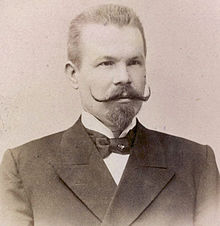Anders Nevalainen

Anders (Antti) Juhaninpoika Nevalainen (1 January 1858 – 1933) was a Finnish gold- and silversmith, and a Fabergé workmaster.
Biography[edit]
Anders Nevalainen was born in Kylänlahti village in Pielisjärvi, Finland. He was an apprentice in Finland and in St. Petersburg in 1874, a goldworker in 1875 (and registered as an employee of Fabergé), and a master goldsmith in 1885, opened his workshop at 35 Kazanskaya Street.[1]
As master first working in the jewelry atelier of August Holmström, he soon became head of workshop under exclusive contract with Fabergé. His workshop made silver-mounted frames in birchwood, palisander or lacquer, silver- and gold cigarette-cases, enameled silver-gilt cases with leather sleeves, several small silver-gilt objects. His initials A.N, mostly used with K.Fabergé mark without the double-headed eagle Imperial Warrant.
Anders Nevalainen later opened his own shop while maintaining his contract with Fabergé. He specialized in embroidered cigarette cases, silver frames, ceramics and woodwork.[1]
The Nevalainen family returned to Finland after the Russian Revolution in 1917. Anders Nevalainen died in Terijoki in 1933.
Signature[edit]
In his book Fabergé’s Eggs: The Extra-ordinary Story of the Masterpieces that Outlived an Empire (2008), Dr Ulla Tillander-Godenhielm argues that workmasters were not using their exact names in their works, and that Anders Nevalainen's actual name is Antti Nevalainen (Anders being the Swedish version of his name).[2]
Family[edit]
In 1884, Anders Nevalainen married Maria Karolina Liljerot (1860–1936). One of their five children, Arvid Nevalainen (1897–1963), was a clockmaster .[1]
Work[edit]
References[edit]
- ^ a b c "Antti Nevalainen, Fabergén kultaseppä". Menevalaiset.net (in Polish). Retrieved 28 August 2018.
- ^ "Workmasters and Marks". Fabergeresearch.com. Retrieved 28 August 2018.
- ^ "Frame with a miniature of Queen Alexandra (1844-1925) 1896 - 1908". Royalcollection.org.uk. Retrieved 28 August 2018.
- ^ "Peter Carl Fabergé and the Fabergé firm" (PDF). Royalcollection.org.uk. Retrieved 28 August 2018.
Bibliography[edit]
- H.C. Bainbridge, Peter Carl Fabergé: Goldsmith and Jeweller to the Russian Imperial Court (1966)
- G.von Habsburg-Lothringen & A.von Solodkoff, Fabergé - Court Jeweler to the Tsars (1979) ISBN 0-914427-09-1
- Geoffrey Watts, Russian Silversmiths' Hallmarks (1700 to 1917) (2006)
- М.М. Постникова-Лосева, Н.Г.П. Платонова, Б.Л. Ульяноа, ЗОЛОТОЕ И СЕРЕБРЯНОЕ ДЕЛО XV-XX вв. (2003)
- Gerard Hill, G.G. Smorodinova and B.L. Ulyanova, Fabergé and the Russian master Goldsmiths (2008)
- Ulla Tillander-Godenhielm, Personal and Historical Notes on Fabergé's Finnish workmasters and designers (page 42.) (1980)
